VIR 483
SRR 14708238
General Information
- Sample Name
- UTT3
- Accession Date
- May 31, 2021
- Reported Plant Sex
- not reported
- Report Type
- Whole-Genome Sequencing
The strain rarity visualization shows how distant the strain is from the other cultivars in the Kannapedia database. The y-axis represents genetic distance, getting farther as you go up. The width of the visualization at any position along the y-axis shows how many strains there are in the database at that genetic distance. So, a common strain will have a more bottom-heavy shape, while uncommon and rare cultivars will have a visualization that is generally shifted towards the top.
Chemical Information
Cannabinoid and terpenoid information provided by the grower.
Cannabinoids
No information provided.
Terpenoids
No information provided.
Genetic Information
- Plant Type
- Type III
File Downloads
The bell curve in the heterozygosity visualization shows the distribution of heterozygosity levels for cannabis cultivars in the Kannapedia database. The green line shows where this particular strain fits within the distribution. Heterozygosity is associated with heterosis (aka hybrid vigor) but also leads to the production of more variable offspring. When plants have two genetically different parents, heterozygosity levels will be higher than if it has been inbred or backcrossed repeatedly.
The ratio of reads mapped to Y-contigs to reads mapped to the whole Cannabis genome (Y-ratios) has been demonstrated to be strongly correlated with plant sex typing. This plot shows the distribution of Y-ratios for all samples in our database which were sequenced with the same method (panel or WGS) as this sample and where this sample falls in the distribution.
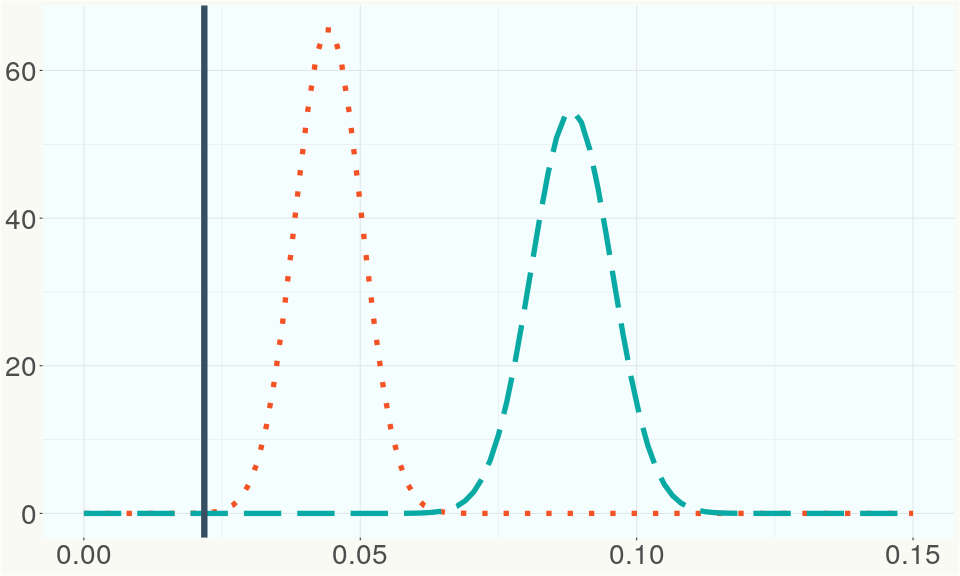
This chart represents the Illumina sequence coverage over the Bt/Bd allele. These are the three regions in the cannabis genome that impact THCA, CBDA, CBGA production. Coverage over the Active CBDAS gene is highly correlated with Type II and Type III plants as described by Etienne de Meijer. Coverage over the THCA gene is highly correlated with Type I and Type II plants but is anti-correlated with Type III plants. Type I plants require coverage over the inactive CBDA loci and no coverage over the Active CBDA gene. Lack of coverage over the Active CBDA and Active THCA allele are presumed to be Type IV plants (CBGA dominant). While deletions of entire THCAS and CBDAS genes are the most common Bt:Bd alleles observed, it is possible to have plants with these genes where functional expression of the enzyme is disrupted by deactivating point mutations (Kojoma et al. 2006).
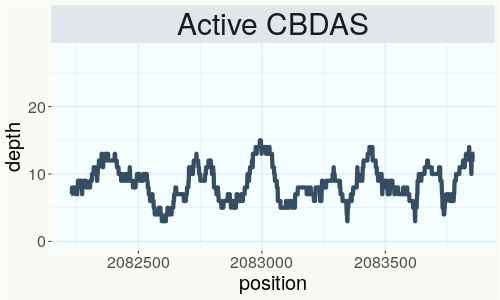
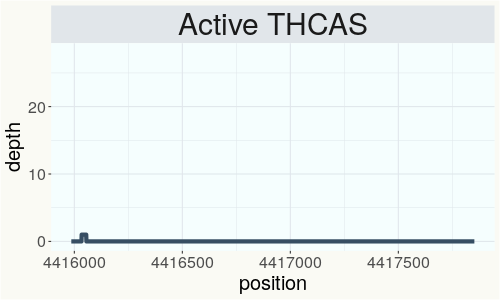
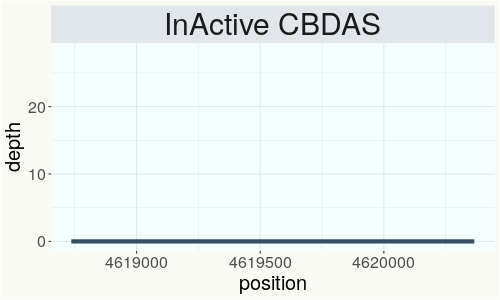
This chart represents the Illumina sequence coverage over the CBCA synthase gene.
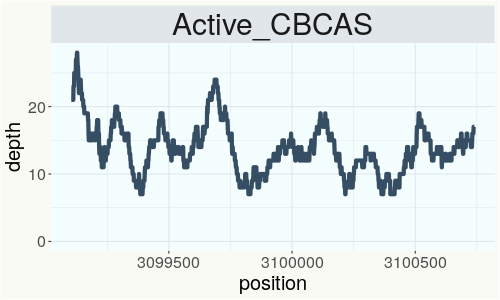
Variants (THCAS, CBDAS, and CBCAS)
No variants to report
Variants (Select Genes of Interest)
| PHL-2 | c.1096G>A | p.Ala366Thr | missense variant | moderate | contig2621 | 340374 | G/A | |
| PHL-2 | c.2783G>A | p.Ser928Asn | missense variant | moderate | contig2621 | 342826 | G/A | |
| PKSG-4a |
c.49_50insTG |
p.Glu16_Gly1 |
disruptive inframe insertion | moderate | contig700 | 1936744 | A/AGGT |
|
| PKSG-4a |
c.1191_1193d |
p.Tyr398del | disruptive inframe deletion | moderate | contig700 | 1938600 | AATT/A |
|
| DXR-2 | c.1319T>C | p.Ile440Thr | missense variant | moderate | contig380 | 285250 | A/G |
|
| aPT1 | c.670T>A | p.Ser224Thr | missense variant | moderate | contig121 | 2840278 | T/A |
|
| aPT1 | c.864C>G | p.Asn288Lys | missense variant | moderate | contig121 | 2842407 | C/G | |
| EMF1-1 | c.242A>G | p.Lys81Arg | missense variant | moderate | contig883 | 269731 | A/G | |
| aPT4 | c.198A>C | p.Lys66Asn | missense variant | moderate | contig121 | 2828854 | A/C |
|
| FLD | c.2686G>A | p.Ala896Thr | missense variant | moderate | contig1450 | 2044848 | C/T | |
| FLD | c.2681T>C | p.Ile894Thr | missense variant | moderate | contig1450 | 2044853 | A/G | |
| GGR | c.456T>A | p.His152Gln | missense variant | moderate | contig2282 | 549448 | T/A |
|
| GGR | c.460G>A | p.Asp154Asn | missense variant | moderate | contig2282 | 549452 | G/A |
|
Nearest genetic relatives (All Samples)
- 0.205 VIR 483 (SRR14708240)
- 0.207 VIR 483 (SRR14708239)
- 0.211 Carmagnola (RSP10979)
- 0.214 VIR 493 - Glukhovskaja 10 Zheltostebel naja (SRR14708230)
- 0.215 Carmagnola (RSP10976)
- 0.215 Carmagnola (RSP10982)
- 0.219 Carmagnola USO 31 (RSP11204)
- 0.219 Tisza (RSP11044)
- 0.220 Ivory (RSP10668)
- 0.220 Santhica27 (RSP11047)
- 0.222 Carmagnola (RSP11039)
- 0.222 Santhica27 (RSP10056)
- 0.223 Carmagnola (RSP10978)
- 0.223 Tisza (RSP11045)
- 0.223 Diana (RSP10235)
- 0.225 Carmagnola (RSP11202)
- 0.226 Tisza (RSP10659)
- 0.226 Santhica 27 (RSP10665)
- 0.227 Tiborszallasie (RSP11210)
- 0.230 VIR 201 (SRR14708232)
Most genetically distant strains (All Samples)
- 0.442 Cherry Blossom (RSP11300)
- 0.439 Cherry Blossom (RSP11301)
- 0.431 AVIDEKEL 2 0 (RSP11174)
- 0.429 Cherry Blossom (RSP11318)
- 0.427 Chematonic -Cannatonic x Chemdawg- (RSP11394)
- 0.426 Northern Skunk (RSP11456)
- 0.425 Chem 91 (RSP11185)
- 0.425 UP Wendigo (RSP11261)
- 0.424 New York City Deisel (RSP11225)
- 0.423 Cherry Blossom (RSP11323)
- 0.423 Medxotic (RSP11410)
- 0.422 Cherry Blossom (RSP11311)
- 0.421 Unknown--Cherry Wine---001- (RSP11268)
- 0.421 Wilburs Great Adventure (RSP11727)
- 0.419 Cherry Blossom (RSP11312)
- 0.419 GMO x Garlic Breath (RSP12507)
- 0.417 Cherry Blossom (RSP11298)
- 0.417 Queen Dream (RSP11278)
- 0.415 Banana OG (RSP11498)
- 0.414 JL Cross 1 (RSP11502)
Nearest genetic relative in Phylos dataset
- Overlapping SNPs:
- 6
- Concordance:
- 6
Nearest genetic relative in Lynch dataset
- Overlapping SNPs:
- 2
- Concordance:
- 2